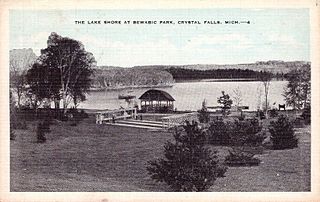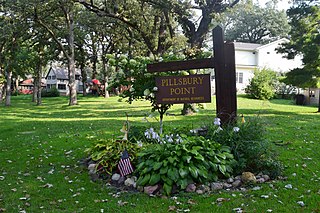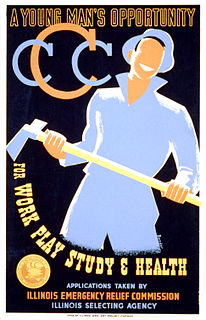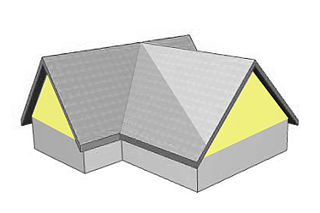
Meramec State Park is a public recreation area located near Sullivan, Missouri, about 60 miles from St. Louis, along the Meramec River. The park has diverse ecosystems such as hardwood forests and glades. There are over 40 caves located throughout the park, the geology of which is a mixture of limestone and dolomite. The most famous is Fisher Cave, located near the campgrounds. The park borders the Meramec Conservation Area.

Bewabic State Park is a public recreation area covering 315 acres (127 ha) on the shore of Fortune Lake, four miles (6.4 km) west of Crystal Falls in Iron County, Michigan. The state park's rich Civilian Conservation Corps history is evidenced by the CCC structures still in use. The park was listed on the National Register of Historic Places for its CCC-related architecture in 2016.

J.W. Wells State Park is a state park in the U.S. state of Michigan. The 678-acre (2.74 km2) park is located in Menominee County on the shore of Lake Michigan's Green Bay, just south of Cedar River. It is on M-35, roughly midway between Menominee and Escanaba. It was added to the National Register of Historic Places in 2002.

Lake Keomah State Park is a state park of Iowa, USA. It is in Mahaska County. To the park's immediate east is Keomah Village and the park is approximately 4 miles (6.4 km) east of Oskaloosa.

Backbone State Park is Iowa's oldest state park, dedicated in 1919. Located in the valley of the Maquoketa River, it is approximately three miles (5 km) south of Strawberry Point in Delaware County. It is named for a narrow and steep ridge of bedrock carved by a loop of the Maquoketa River originally known as the Devil's Backbone. The initial 1,200 acres (490 ha) were donated by E.M. Carr of Lamont, Iowa. Backbone Lake Dam, a relatively low dam built by the Civilian Conservation Corps (CCC) in the 1930s, created Backbone Lake. The CCC constructed a majority of trails and buildings which make up the park.

The Black Moshannon State Park Historic Districts are three separate historic districts on the National Register of Historic Places (NRHP) at Black Moshannon State Park in Rush Township, Centre County, Pennsylvania in the United States. The structures in the historic districts were constructed in the 1930s during the Great Depression by the Civilian Conservation Corps (CCC). The three districts are: the Beach and Day Use District, with 18 contributing structures, including 11 different picnic pavilions, concession building, bathhouse, museum, and four open pit latrines; the Family Cabin District with 16 contributing properties, including 13 cabins, one lodge and two latrines; and the Maintenance District with four contributing properties, including a storage building, three-bay garage, gas pump house, and ranger's residence.

The Glacier Point Trailside Museum was one of the first projects in Yosemite National Park by Herbert Maier in what would become the National Park Service Rustic style. Located at Glacier Point, it was funded by Laura Spelman Rockefeller's estate as a project for the Yosemite Museum. It was the first "trailside museum" in the National Park system and was a prototype for enhanced visitor interpretation services in the parks.

The Utah Parks Company Service Station in Bryce Canyon National Park was built in 1947 to serve automobile-borne visitors to the park. The service station was designed for the Utah Parks Company by architect Ambrose Spence in a style that was sympathetic to the prevailing National Park Service Rustic style, but was much simpler and more modern in character. In this manner, it foreshadowed the consciously simplified designs developed during the Mission 66 project.

Gull Point State Park is a state park of Iowa, United States, located on West Okoboji Lake in the city of Wahpeton. It is the primary state park unit in the Iowa Great Lakes region. Two areas of the park were listed as nationally recognized historic districts on the National Register of Historic Places in 1990.

The American Legion Forest CCC Shelter is a historic rustic log shelter, located on the west side of West River Road within the American Legion State Forest in Barkhamsted, Connecticut. It is the only surviving one of four such structures in the area built by the Civilian Conservation Corps (CCC), and one of only three CCC-built shelters to survive in the state. The shelter was listed on the National Register of Historic Places in 1986.

The Libby Museum is a natural history museum at 755 North Main Street in Wolfeboro, New Hampshire. The museum was founded by Dr. Henry Libby in 1912, and was the first museum in the state dedicated solely to its natural history. It is owned by the town of Wolfeboro, and is open seasonally between June and October. The museum's building was listed on the National Register of Historic Places in 1998.

The Swallow Boathouse is a historic boathouse on Lake Winnipesaukee in central New Hampshire, United States. It is located in a cove on the west side of Moultonborough Neck, in the town of Moultonborough. Built in 1908-10, it is one of the state's most architecturally elaborate boathouses, exhibiting elements of the Tudor Revival and Shingle style. Now used exclusively by the association owners, it was listed on the National Register of Historic Places in 1980.

The Thayer Lake East Shelter Cabin is the ruined remains of a historic backcountry shelter in the Admiralty Island National Monument, part of the Tongass National Forest in Southeast Alaska. It was one of a number of such facilities built by Civilian Conservation Corps (CCC) on the Admiralty Island Canoe Route between 1933 and 1937. This cabin, a three-sided Adirondack-style log structure with shake walls and roof, was built in 1936, and located on the lake near the portage trail connecting to Distin Lake. Unlike other cabins built by the CCC on the island, which were of post-and-beam construction, in this one the logs were saddle-notched together at the corners.

Pilot Knob State Park is located southeast of Forest City, Iowa, United States. Founded in 1923, it is one of the oldest state parks in Iowa. Between 1990 and 1995 one area was named nationally recognized historic district and five structures were individually listed on the National Register of Historic Places.

Lacey-Keosauqua State Park is located southwest of Keosauqua, Iowa, United States. Located along the Des Moines River in Van Buren County, it was dedicated in 1921. It is the largest state park in size in Iowa. In 1990 three areas were named nationally recognized historic districts and listed on the National Register of Historic Places.

Pillsbury Point State Park is located in Arnolds Park, Iowa, United States. It is Iowa's smallest state park and unlike the others, it is an urban park. At 6.48 acres (2.62 ha), it is a narrow park that extends along a point of land into West Okoboji Lake adjacent to private summer houses. The overlook at the north end of the park was listed on the National Register of Historic Places in 1990. The historic designation includes walkways along the lake, stone steps, stone benches, and property boundary markers.

Pikes Point State Park is located southwest of Spirit Lake, Iowa, United States. It is a small park on a point of land that projects into West Okoboji Lake. It provides space for picnicking, including a shelter listed on the National Register of Historic Places, a playground, a swimming beach, boating and fishing on the lake.

Mini-Wakan State Park is located north of Spirit Lake, Iowa, United States. The 20-acre (8.1 ha) park is along the north shore of Big Spirit Lake. It provides space for picnicking, hiking, biking, swimming, boating and fishing on the lake. The park is connected to the Dickinson County trail system in Iowa and the Jackson County trail system in Minnesota. It was listed as a historic district on the National Register of Historic Places in 2010.

Wanata State Park Picnic Shelter is a historic building located south of Peterson, Iowa, United States. Dr. E.W. Spaulding from Peterson was instrumental in acquiring the property for the park, which was dedicated in 1934. Civilian Conservation Corps Company 778 built the shelter on the slope of a hill that descends to the Little Sioux River. The rear and side walls are composed of random rubble stone. There are four stone pillars across the front, and four vertical timbers attached to them that support the eaves of the gable roof. Each side wall has a doorway and window opening. A fireplace and chimney are centered on the rear wall. There is a small stone basement in the northwest corner, and cemented stone covers the floor of the shelter. It was listed on the National Register of Historic Places in 1990.

The Capt. Nicholas W. and Emma Johnson House is a historic building located in Des Moines, Iowa, United States. The house is significant for its being an unusual example in Des Moines of Châteauesque design elements added to a late Queen Anne style house. The design was attributed to Des Moines architect Oliver O. Smith, and it was built by local contractor Charles Weitz. This 2½-story brick structure features large massing, a prominent front-facing gable, two full-height polygonal side bays, steeply pitched hipped roof, smooth and rough wall surfaces, contrasting courses, and the fleur-de-lis motif executed in stone, ceramic tile, and glass.

























